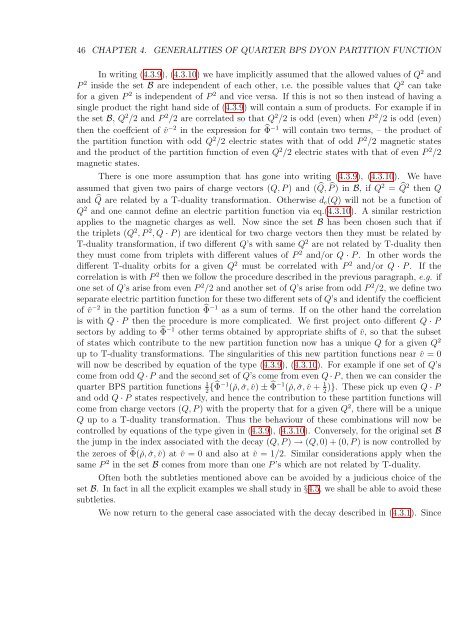PHYS08200604018 Shamik Banerjee - Homi Bhabha National ...
PHYS08200604018 Shamik Banerjee - Homi Bhabha National ...
PHYS08200604018 Shamik Banerjee - Homi Bhabha National ...
You also want an ePaper? Increase the reach of your titles
YUMPU automatically turns print PDFs into web optimized ePapers that Google loves.
46 CHAPTER 4. GENERALITIES OF QUARTER BPS DYON PARTITION FUNCTION<br />
In writing (4.3.9), (4.3.10) we have implicitly assumed that the allowed values of Q 2 and<br />
P 2 inside the set B are independent of each other, ı.e. the possible values that Q 2 can take<br />
for a given P 2 is independent of P 2 and vice versa. If this is not so then instead of having a<br />
single product the right hand side of (4.3.9) will contain a sum of products. For example if in<br />
the set B, Q 2 /2 and P 2 /2 are correlated so that Q 2 /2 is odd (even) when P 2 /2 is odd (even)<br />
then the coeffcient of ˇv −2 in the expression for ̂Φ −1 will contain two terms, – the product of<br />
the partition function with odd Q 2 /2 electric states with that of odd P 2 /2 magnetic states<br />
and the product of the partition function of even Q 2 /2 electric states with that of even P 2 /2<br />
magnetic states.<br />
There is one more assumption that has gone into writing (4.3.9), (4.3.10). We have<br />
assumed that given two pairs of charge vectors (Q, P ) and ( ̂Q, ̂P ) in B, if Q 2 = ̂Q 2 then Q<br />
and ̂Q are related by a T-duality transformation. Otherwise d e (Q) will not be a function of<br />
Q 2 and one cannot define an electric partition function via eq.(4.3.10). A similar restriction<br />
applies to the magnetic charges as well. Now since the set B has been chosen such that if<br />
the triplets (Q 2 , P 2 , Q · P ) are identical for two charge vectors then they must be related by<br />
T-duality transformation, if two different Q’s with same Q 2 are not related by T-duality then<br />
they must come from triplets with different values of P 2 and/or Q · P . In other words the<br />
different T-duality orbits for a given Q 2 must be correlated with P 2 and/or Q · P . If the<br />
correlation is with P 2 then we follow the procedure described in the previous paragraph, e.g. if<br />
one set of Q’s arise from even P 2 /2 and another set of Q’s arise from odd P 2 /2, we define two<br />
separate electric partition function for these two different sets of Q’s and identify the coefficient<br />
of ˇv −2 in the partition function ̂Φ −1 as a sum of terms. If on the other hand the correlation<br />
is with Q · P then the procedure is more complicated. We first project onto different Q · P<br />
sectors by adding to ̂Φ −1 other terms obtained by appropriate shifts of ˇv, so that the subset<br />
of states which contribute to the new partition function now has a unique Q for a given Q 2<br />
up to T-duality transformations. The singularities of this new partition functions near ˇv = 0<br />
will now be described by equation of the type (4.3.9), (4.3.10). For example if one set of Q’s<br />
come from odd Q · P and the second set of Q’s come from even Q · P , then we can consider the<br />
quarter BPS partition functions 1{̂Φ −1 (ˇρ, ˇσ, ˇv) ± ̂Φ −1 (ˇρ, ˇσ, ˇv + 1 )}. These pick up even Q · P<br />
2 2<br />
and odd Q · P states respectively, and hence the contribution to these partition functions will<br />
come from charge vectors (Q, P ) with the property that for a given Q 2 , there will be a unique<br />
Q up to a T-duality transformation. Thus the behaviour of these combinations will now be<br />
controlled by equations of the type given in (4.3.9), (4.3.10). Conversely, for the original set B<br />
the jump in the index associated with the decay (Q, P ) → (Q, 0) + (0, P ) is now controlled by<br />
the zeroes of ̂Φ(ˇρ, ˇσ, ˇv) at ˇv = 0 and also at ˇv = 1/2. Similar considerations apply when the<br />
same P 2 in the set B comes from more than one P ’s which are not related by T-duality.<br />
Often both the subtleties mentioned above can be avoided by a judicious choice of the<br />
set B. In fact in all the explicit examples we shall study in §4.5, we shall be able to avoid these<br />
subtleties.<br />
We now return to the general case associated with the decay described in (4.3.1). Since

















